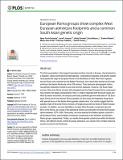Por favor, use este identificador para citar o enlazar a este item:
http://hdl.handle.net/10261/207422COMPARTIR / EXPORTAR:
 SHARE SHARE
 CORE
BASE CORE
BASE
|
|
| Visualizar otros formatos: MARC | Dublin Core | RDF | ORE | MODS | METS | DIDL | DATACITE | |

| Título: | European Roma groups show complex West Eurasian admixture footprints and a common South Asian genetic origin |
Autor: | Font-Porterias, Neus CSIC ORCID; Arauna, Laura R.; Poveda, Alaitz; Bianco, Erica CSIC ORCID; Rebato, Esther; Prata, Maria João; Calafell, Francesc CSIC ORCID ; Comas, David CSIC ORCID | Fecha de publicación: | 23-sep-2019 | Editor: | Public Library of Science | Citación: | PLoS Genetics 15(9): e1008417 (2019) | Resumen: | The Roma population is the largest transnational ethnic minority in Europe, characterized by a linguistic, cultural and historical heterogeneity. Comparative linguistics and genetic studies have placed the origin of European Roma in the Northwest of India. After their migration across Persia, they entered into the Balkan Peninsula, from where they spread into Europe, arriving in the Iberian Peninsula in the 15th century. Their particular demographic history has genetic implications linked to rare and common diseases. However, the South Asian source of the proto-Roma remains still untargeted and the West Eurasian Roma component has not been yet deeply characterized. Here, in order to describe both the South Asian and West Eurasian ancestries, we analyze previously published genome-wide data of 152 European Roma and 34 new Iberian Roma samples at a fine-scale and haplotype-based level, with special focus on the Iberian Roma genetic substructure. Our results suggest that the putative origin of the proto-Roma involves a Punjabi group with low levels of West Eurasian ancestry. In addition, we have identified a complex West Eurasian component (around 65%) in the Roma, as a result of the admixture events occurred with non-proto-Roma populations between 1270-1580. Particularly, we have detected the Balkan genetic footprint in all European Roma, and the Baltic and Iberian components in the Northern and Western Roma groups, respectively. Finally, our results show genetic substructure within the Iberian Roma, with different levels of West Eurasian admixture, as a result of the complex historical events occurred in the Peninsula. | Versión del editor: | http://doi.org/10.1371/journal.pgen.1008417 | URI: | http://hdl.handle.net/10261/207422 | DOI: | 10.1371/journal.pgen.1008417 | Identificadores: | doi: 10.1371/journal.pgen.1008417 e-issn: 1553-7404 issn: 1553-7390 |
| Aparece en las colecciones: | (IBE) Artículos |
Ficheros en este ítem:
| Fichero | Descripción | Tamaño | Formato | |
|---|---|---|---|---|
| european_Roma_groups_admixture_footprints_Asian_genetic.pdf | 1,54 MB | Adobe PDF |  Visualizar/Abrir |
CORE Recommender
PubMed Central
Citations
19
checked on 22-mar-2024
SCOPUSTM
Citations
23
checked on 16-abr-2024
WEB OF SCIENCETM
Citations
24
checked on 25-feb-2024
Page view(s)
153
checked on 24-abr-2024
Download(s)
127
checked on 24-abr-2024

